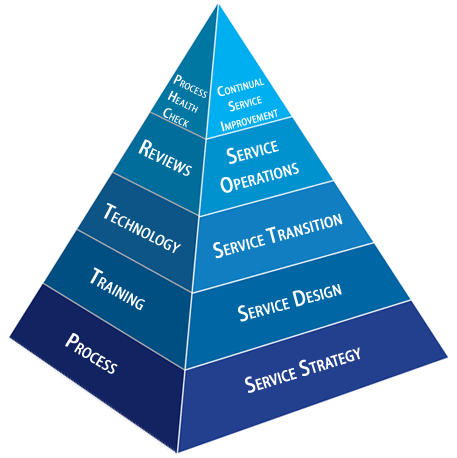Core Elements of Service Management
Service Strategy

Service Strategy is the phase in which we discuss in detail with the customer on designing, developing and implementing the service model – These discussions are held both from an operational capability perspective and a strategic perspective. Here we try to ensure that consideration is given as to why a particular activity is to be performed - before we begin to think about how it will be performed.
Service Design
The Service Design stage of the lifecycle generally starts with a set of new or changed business requirements and ends with the development of a solution designed to meet the documented needs of the process. This developed solution, together with the process transition manual, is then passed to transition team to build, test and deploy the new or changed service and on completion of these activities control is transferred to the service operations team and continual service improvement stages.
Service Transition
The service transition stage provides guidance on ensuring that the introduction, deployment, transfers and decommissioning of new or changed services is consistently well managed. This stage ensures that the transition processes are streamlined, effectively and efficiently so that the risks relating to the service in transition are minimised. This stage of the lifecycle receives input from the service design stage and provides output to the service operations stage.
Service Operations
Service operations team is responsible for all aspects of managing the day-to-day operation of services, ensuring that processes and activities are operated (and continue to be operated) on a ‘business as usual’ basis. The key purpose of this team is to coordinate and perform the processes and activities that support the delivery of the services at the levels defined in the relevant Service Level Agreements. The scope of this team covers the services, the service management processes, the underpinning technology used to deliver those services and the people used to manage all of these aspects.
Continual Service Improvement
The Continual Service Improvement is not a standalone stage or a stage that comes after the process of transition is complete. It is a wrapper which is used throughout the service lifecycle. It has inputs and outputs for all lifecycle stages. It focuses on the overall health of Service Management within the organisation.
While the above stages are part of the core transition and service delivery model, it is important to note that the processes being implemented and followed, the training that is being imparted to the process executives and the technological tools being used to run the processes followed up with continuous reviews and process health checks play an important role in the transitioning of the process. The focus here will be on the customer-centric delivery along with the continuous improvement mechanism by applying the best practices from various business verticals and service horizontals.
